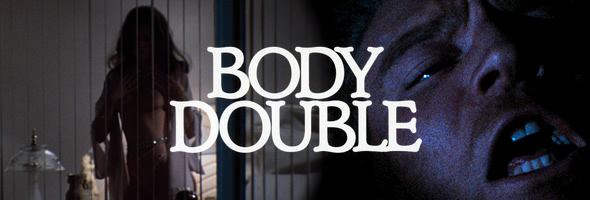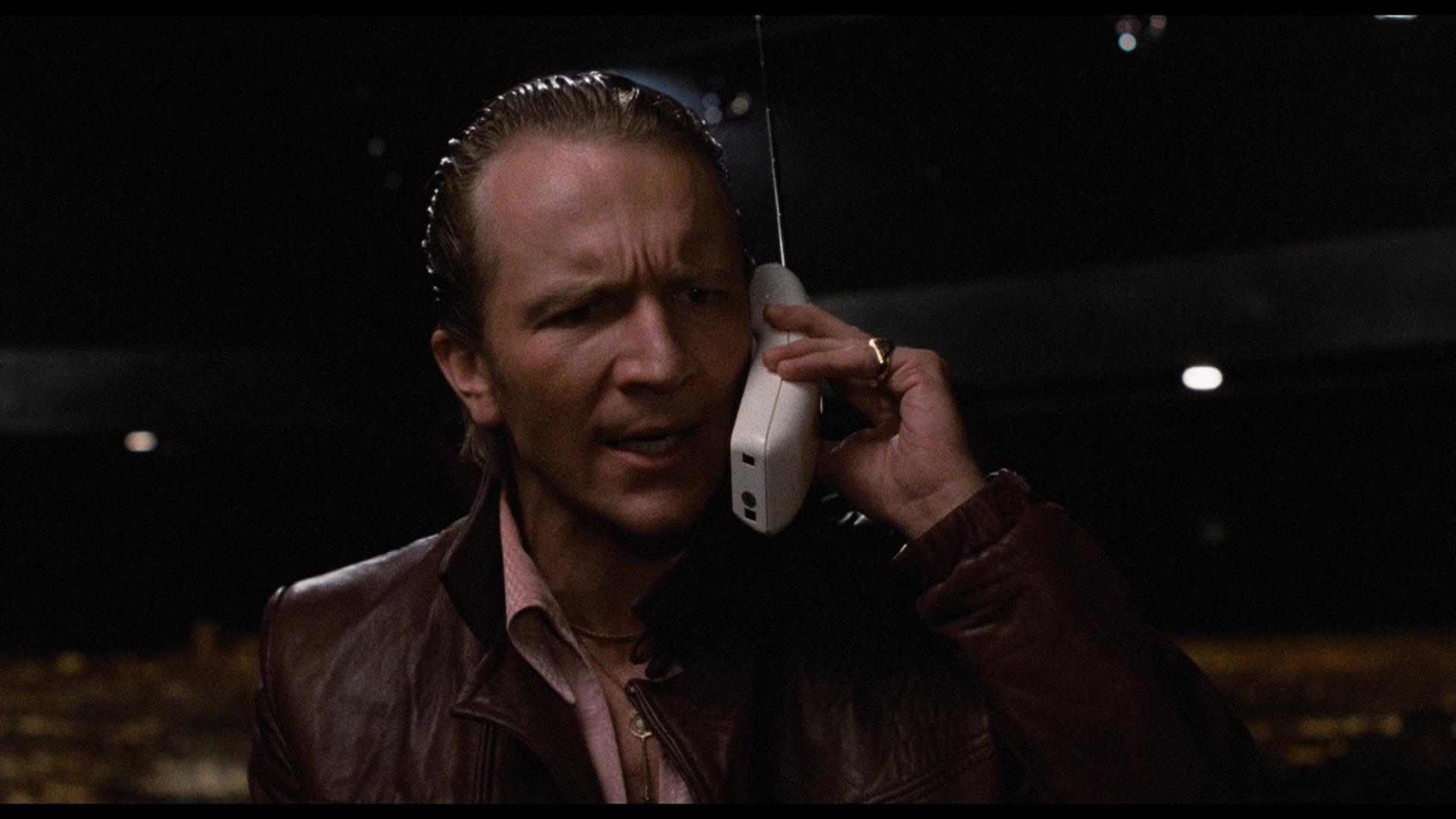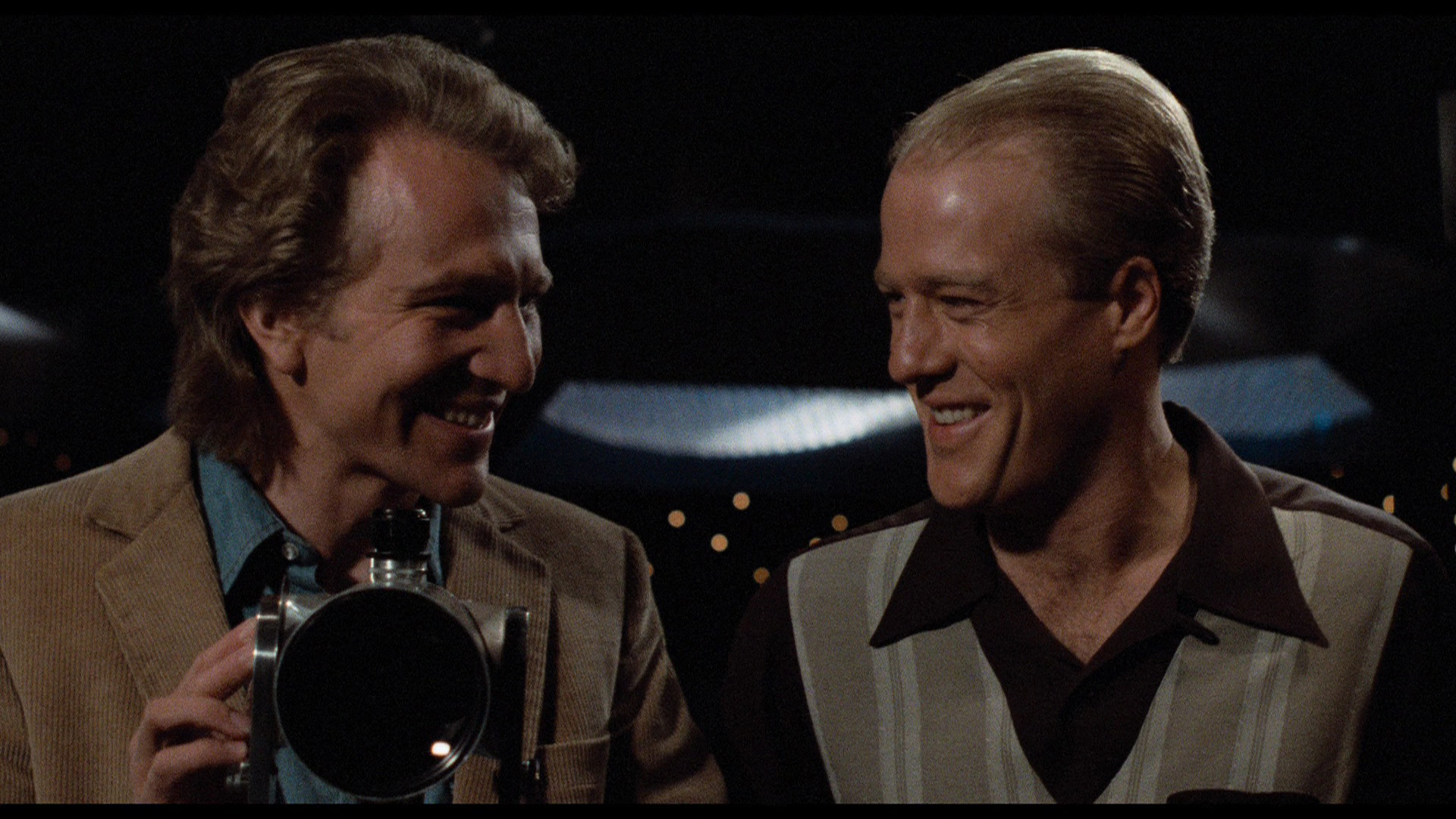
Color, 1984, 114m.
Directed by Brian De Palma
Starring Craig Wasson, Melanie Griffith, Gregg Henry, Deborah Shelton, Guy Boyd, Dennis Franz
Indicator (Blu-ray) (UK R0 HD), Twilight Time (Blu-ray) (US R0 HD), Carlotta (Blu-ray) (France RB HD), Sony (DVD) (US/UK R1/R2 NTSC/PAL) / WS (1.85:1) (16:9)

 Almost all of Brian De Palma’s thrillers have undergone major reappraisals in recent years after the charges of Hitchcock copycatting died down, and few have benefited more than Body Double, a giddy ride through mid-‘80s West Coast excess that tosses logic out the window in favor of sheer, breakneck entertainment. Having come off of a protracted battle with the MPAA over the previous year’s Scarface and still stinging from the box office failure of Blow Out, De Palma was definitely in confrontational mode here when he pulled out all the stops for a complex but playful mash up of horror, crime film, and sex-crazed comedy, complete with a gruesome drill murder and depictions of the L.A. adult film scene designed to make the ratings board go ballistic. The gambit failed, however, thanks to the simultaneous submission of Ken Russell’s far more distracting Crimes of Passion, which left the MPAA in a generous mood with only a minor trim to the end of the famous window routine forced upon De Palma’s film. Despite the lukewarm response, it’s a film that seems to get better with each passing year and holds up astonishingly well to repeated viewings.
Almost all of Brian De Palma’s thrillers have undergone major reappraisals in recent years after the charges of Hitchcock copycatting died down, and few have benefited more than Body Double, a giddy ride through mid-‘80s West Coast excess that tosses logic out the window in favor of sheer, breakneck entertainment. Having come off of a protracted battle with the MPAA over the previous year’s Scarface and still stinging from the box office failure of Blow Out, De Palma was definitely in confrontational mode here when he pulled out all the stops for a complex but playful mash up of horror, crime film, and sex-crazed comedy, complete with a gruesome drill murder and depictions of the L.A. adult film scene designed to make the ratings board go ballistic. The gambit failed, however, thanks to the simultaneous submission of Ken Russell’s far more distracting Crimes of Passion, which left the MPAA in a generous mood with only a minor trim to the end of the famous window routine forced upon De Palma’s film. Despite the lukewarm response, it’s a film that seems to get better with each passing year and holds up astonishingly well to repeated viewings.
After a bad day at work on a cheap vampire film thanks to a sudden bout of claustrophobia, struggling actor Jake Scully (Ghost Story’s Wasson) finds his bad day going further downhill when he catches  his girlfriend (a quick bit by Re-animator’s Barbara Crampton) in the sack with another man. Jake finds another place to crash thanks to a sudden housesitting gig offered by fellow acting class student Sam (Henry), who has to leave town and
his girlfriend (a quick bit by Re-animator’s Barbara Crampton) in the sack with another man. Jake finds another place to crash thanks to a sudden housesitting gig offered by fellow acting class student Sam (Henry), who has to leave town and  puts Jake in charge of a modern house on stilts in the Hollywood Hills (the still-standing Chemosphere) complete with a neighbor who performs a nude dance in front of the window every night. Jake becomes obsessed with the mystery woman across the way, the unhappily married Gloria (Shelton, dubbed by Helen Shaver), whom he follows and nearly beds over an afternoon of shopping and beach escapism. However, Gloria’s also being stalked by a menacing Indian whose violent streak drags Jake into a dark mystery involving the police and the local porn industry, specifically a popular star named Holly Body (Griffith).
puts Jake in charge of a modern house on stilts in the Hollywood Hills (the still-standing Chemosphere) complete with a neighbor who performs a nude dance in front of the window every night. Jake becomes obsessed with the mystery woman across the way, the unhappily married Gloria (Shelton, dubbed by Helen Shaver), whom he follows and nearly beds over an afternoon of shopping and beach escapism. However, Gloria’s also being stalked by a menacing Indian whose violent streak drags Jake into a dark mystery involving the police and the local porn industry, specifically a popular star named Holly Body (Griffith).
De Palma did extensive research on the L.A. hardcore scene for this film and originally intended the role of Holly for Annette Haven (who can still be glimpsed briefly in the porn movie shoot), but studio resistance wound up giving Griffith her big break in a role that easily overshadows her leading man (who’s actually better than many realize, but it’s a far less flashy part). She’s sparkling and hilarious here, creating a character worthy of a screwball comedy and establishing a look that would actually be imitated by the West Coast porn scene for the rest of the decade. Perhaps one reason the film struck a nerve at the height of the Reagan era is its refusal to paint the porn industry as a cesspool or a corrupting influence; as far as studio fare goes, it’s about the most even-handed and bemused look at the industry you’re likely to find. 
It’s also great to see De Palma regular Dennis Franz popping up here in a couple of scenes as a backstabbing director, and the great Pino Donaggio contributes another lush, highly memorable score with the pulsating window theme marking one of his career highlights. On top of that you get a great faux music video for “Relax” complete with Frankie Goes to Hollywood in person, a quick appearance by scream queen  Brinke Stevens, priceless footage of the 1984 Tower Records on Sunset Blvd., and layers and layers of De Palma cinematic gamesmanship about the nature of acting and cinematic perception. It’s a film built entirely on fantasy and artifice, drifting in and out of Jake’s fantasies and nightmares with artificial backdrops and lighting calling everything into question from the opening frames in a deliberately unconvincing cemetery to Jake’s climactic ordeal in a “real” but no less cinematic handmade grave.
Brinke Stevens, priceless footage of the 1984 Tower Records on Sunset Blvd., and layers and layers of De Palma cinematic gamesmanship about the nature of acting and cinematic perception. It’s a film built entirely on fantasy and artifice, drifting in and out of Jake’s fantasies and nightmares with artificial backdrops and lighting calling everything into question from the opening frames in a deliberately unconvincing cemetery to Jake’s climactic ordeal in a “real” but no less cinematic handmade grave.
Not surprisingly, Body Double turned out to be a much bigger hit on home video and cable TV than its sad fate on the big screen, and it’s been perpetually in circulation for decades. Sony issued it twice on DVD, first in 2000 in a modest edition only sporting the film’s superb, award-winning trailer (featuring John Barry’s music for Body Heat) which has since been missing from many releases. A 2006 reissue ditched the trailer, glossed the film up with an improved new transfer and featured four Laurent Bouzereau featurettes with De Palma, Griffith,  and other cast and crew members: “The Seduction” (17 mins.), “The Setup” (17 mins.), “The Mystery (12 mins.), and “The Controversy” (6 mins). All are excellent and illuminating, though surprisingly, little attention is given to the film’s evolutionary process that continued almost up to shooting; for example, an issue of Film Comment around the time of its release featuring script excerpts that showed up much the film was shuffled around by the time it went before the cameras (including moving the actual on-set “body double” scene from the opening to the end).
and other cast and crew members: “The Seduction” (17 mins.), “The Setup” (17 mins.), “The Mystery (12 mins.), and “The Controversy” (6 mins). All are excellent and illuminating, though surprisingly, little attention is given to the film’s evolutionary process that continued almost up to shooting; for example, an issue of Film Comment around the time of its release featuring script excerpts that showed up much the film was shuffled around by the time it went before the cameras (including moving the actual on-set “body double” scene from the opening to the end).
A limited  edition 2013 Blu-ray of the film from Twilight Time sold out quickly and became a collector’s item, porting over the four featurettes and adding a Donaggio isolated score (for those who missed out on the very in-demand soundtrack release by Intrada) and featuring liner notes by Julie Kirgo. The new 4K HD transfer was supervised by cinematographer Stephen H. Burum, and the label, still smarting from criticisms over its infamous Blu-ray of the Night of the Living Dead remake, issued a statement beforehand that the color scheme would look different than previous home video version, which tended to veer on the warm rose side. They didn’t need to worry, as the film looks terrific with more natural skin tones and a nice, healthy grain structure, plus a solid DTS-HD MA 5.1 soundtrack that basically replicates the film’s Dolby Stereo presentation with a little more atmosphere filled out in the rear channels. (Avoid the lousy Australian Blu-ray at all costs.) The same 4K-based transfer was given a more generous encoding on the French Blu-rays from Carlotta in late 2015, either a standalone slipcase disc
edition 2013 Blu-ray of the film from Twilight Time sold out quickly and became a collector’s item, porting over the four featurettes and adding a Donaggio isolated score (for those who missed out on the very in-demand soundtrack release by Intrada) and featuring liner notes by Julie Kirgo. The new 4K HD transfer was supervised by cinematographer Stephen H. Burum, and the label, still smarting from criticisms over its infamous Blu-ray of the Night of the Living Dead remake, issued a statement beforehand that the color scheme would look different than previous home video version, which tended to veer on the warm rose side. They didn’t need to worry, as the film looks terrific with more natural skin tones and a nice, healthy grain structure, plus a solid DTS-HD MA 5.1 soundtrack that basically replicates the film’s Dolby Stereo presentation with a little more atmosphere filled out in the rear channels. (Avoid the lousy Australian Blu-ray at all costs.) The same 4K-based transfer was given a more generous encoding on the French Blu-rays from Carlotta in late 2015, either a standalone slipcase disc  or a lavish set housed in a large oversized box with a 200-page book. Extras here include the featurettes, the trailer, a Samuel Blumfeld intro, and a terrific 38-minute interview with De Palma assistant director Joe Napolitano, “Pure Cinema.”
or a lavish set housed in a large oversized box with a 200-page book. Extras here include the featurettes, the trailer, a Samuel Blumfeld intro, and a terrific 38-minute interview with De Palma assistant director Joe Napolitano, “Pure Cinema.”
Offering the best of all possible options is the 2016 UK region-free Blu-ray from Indicator, a Powerhouse Films brand, which sports an expert encoding that easily matches up against the Carlotta and makes for a very satisfying viewing experience all around. It also has optional English subtitles and both the DTS-HD MA 5.1 mix and the original 2.0 theatrical mix as English LPCM, with the isolated score carried over here. Extras include the trailer, the “Pure Cinema” featurette, all four 2006 featurettes, an 8-minute vintage interview with Wasson about prepping for his role, and a hefty gallery of poster, stills, and other promo ephemera. Don’t overlook the excellent (and very well designed!) liner notes booklet, which comes stuffed with an Ashley Clark essay (“Forget It Jake, It’s Hollywood”) noting the film’s peculiar charms and unexpected similarities to Muholland Drive, a reprint of the memorable 1984 De Palma Film Comment interview (“I’m a visual stylist!”) from what may be the magazine’s sleaziest issue ever (which also covered The Texas Chainsaw Massacre 2 and vintage exploitation and nudist camp films), a 1987 Film Comment interview with De Palma about his favorite cinematic “guilty pleasures,” and a very nasty 1984 review by Richard Combs that offers a nice snapshot of how the critical world at large reacted to De Palma’s film when it opened. Very highly recommended.
Reviewed on October 21, 2016.










